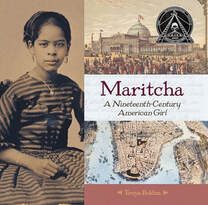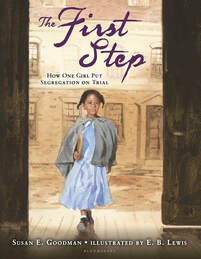|
Entry written by Jennifer Graff and Courtney Shimek, on behalf of The Biography Clearinghouse.
|
Research & Writing Process
|
Tonya's Process
Listen to Tonya explain how she researched and wrote Maritcha. In particular, she addresses:
|
Craft & Structure
Tonya Bolden offers us wonderful opportunities to understand the power of language for identity development through her use of quotes from Maritcha Rémond Lyons, descriptive language, and the intentionality behind source references within the narrative.
Strong Voice
|
Maritcha’s strong voice is easily heard through Bolden’s increasing use of quotes from Maritcha’s autobiography/memoir as we progress through the narrative. Identify key quotes that help construct an image of Maritcha and discuss how Bolden uses Maritcha’s words to build her identity.
|
Have students review primary source data (e.g., their journal or personal writing, text messages, novels or picturebook biographies, website content, interviews with other people, etc.) and identify key quotes that help build the person or character’s identity.
|
Descriptive & Varied Language
|
Descriptive and varied language is critical to create engaging text. Bolden offers a plethora of examples of how language can evoke powerful imagery and bring people and contexts to life.
|
Have students select and share a sentence that they wished they would have written. Students can also revisit their own writing and revise with some of Bolden’s language and structures in mind.
|
Speculative Voice
|
Bolden identifies informed hypotheses of Maritcha and her family when using secondary sources or drawing conclusions based on universal (or timeless) habits. These examples among others can be models for how students can share information in their own writing and establish trustworthiness.
|
Talk with students about what it means to be a trustworthy author. Have them review each other’s nonfiction writing to look for trustworthiness and offer possible revisions where needed.
Have students compare and contrast the language used in this biography with the language used in historical fiction texts. |
Content & Disciplinary ThinkingWe learned so much about Mariticha, the community she was raised in, and the history of New York City through Bolden’s powerful writing and illustrative primary sources. Here is an assortment of other resources providing additional information about the Draft Riots of 1863 and connecting Mariticha to other children who led school desegregation events. These resources specifically provide more context, background knowledge, and individuals to consider adding to your curriculum.
|
The Draft Riots of 1863
We found ourselves continuing to ask questions about the Lyons family and the experiences of Black families in New York City during the Draft Riots of 1863. As we read about the targeting and killing of different groups of people including “blacks of all classes” (p.25) during the Riots, we thought about the many ways Black people are continually targeted. We saw the connections between white people’s anger and violence toward Black people in 1863 and what is happening now in 2020, including the tragic and terrorizing killings of George Floyd, Breonna Taylor, Ahmaud Arbery, among so many others. The violence has never stopped. How do people respond to systemic injustices? Why and how do social protests occur, and why do people take to the streets? How are different community protests characterized and what are the implications? What language, or terms, are used by media outlets to characterize these movements? How do these characterizations inform societal responses or opinions?
These questions invited us to do more research. Here are some primary and secondary sources we found useful in better understanding the 1863 Draft Riots. These resources may also help you connect the riots with other important historical and contemporary events. Links with an asterisk provide curricular ideas, specifically.
For even more information about the New York Draft Riots, we recommend the following resources:
These questions invited us to do more research. Here are some primary and secondary sources we found useful in better understanding the 1863 Draft Riots. These resources may also help you connect the riots with other important historical and contemporary events. Links with an asterisk provide curricular ideas, specifically.
- Zinn Education Project: July 13, 1863 Draft Riots *
- The Washington Post: “The New York Draft Riots of 1863”
- The New York TImes: “Black New York and the Draft Riots”
For even more information about the New York Draft Riots, we recommend the following resources:
U.S. Desegregation Cases
|
We connected Maritcha’s desegregation case with other children who experienced desegregation trials, highlighted in books such as The First Step: How One Girl Put Segregation on Trial by Susan Goodman and E. B. Lewis (2016), Todos Iguales/All Equal: Un corrido de Lemon Grove/A Ballad of Lemon Grove by Christy Hale (2019), and Separate is Never Equal: Sylvia Mendez and Her Family’s Fight for Desegregation by Duncan Tonatiuh (2014).
|
|
We kept asking ourselves, what connections can we make across these different cases? What has changed? What remains the same? What actions can we take, informed by our study of the past, to make changes in the present?
Here are the primary and secondary sources we found helpful in learning more about each of these cases included in the aforementioned picturebooks. Links with an asterisk provide curricular ideas, specifically. |
Sarah Roberts’ 1847 Desegregation Case
- Digital Public Library: Busing and Desegregation in Boston *
- Archives and Public History, University of Massachusetts Boston, Sarah RobertsSmithsonian Museum, “Separate is Never Equal: In Pursuit of Equality”
- Massachusetts Historical Society: “Sarah C. Roberts vs. The City of Boston”
- The Boston Globe, 2018, “Boston’s Schools are Becoming Resegregated”
- WBUR, 2020, “As Boston Grows in Wealth and Diversity, Many Schools are Intensely Segregated”
Roberto Álvarez’s 1930 Desegregation Case
- Zinn Education Project: January 5, 1931: The Lemon Grove Incident *
- San Diego History Center, 1986, “The Lemon Grove Incident”
- San Diego Free Press, 2019, “Lemon Grove Oral History Project”
- Los Angeles Times, 2019, “School Busing and Race Tore L.A. Apart in the 1970s. Now, Kamala Harris is Reviving the Debate”
- The New York Times, 2019, “Separate Programs for Separate Communities: California School District Agrees to Desegregate”
Sylvia Mendez’s 1944 Desegregation Case
New Texts & ArtifactsInformed by the Investigate and Explore sections, here are some ways in which students can create inspired artifacts informed by Bolden’s Maritcha. While we used Maritcha as an anchor text, the other texts we recommend in the Explore section are also applicable. We envision the following instructional possibilities to build upon one another. Thus, the 1-2 hour activities are independent; however, they serve as building blocks for the activities described for those of you who have more than a couple of hours. The more time you have, the more in-depth and nuanced the activities can be. Also, while we offer class compositions for the activities, they are guideposts and should change depending on your learning environment.
|
Preserving Family Memories
Bolden used greeting cards, newspaper clippings, diary entries, Maritcha’s autobiography, photographs, etc. to help reconstruct Maritcha’s childhood, complete with family memories and personal trials and tribulations. Students can imagine that a biographer wants to write about them. What would students select to offer (or leave behind for) biographers to use when writing about them?
If you have 1-2 hours . . .Students discuss or free-write about their family memories. Students also think about what artifact they would want to include with their oral or written memory.
|
If you have 1-2 days . . .Students find an artifact and share that piece (in person or via Flipgrid, VoiceThread, etc.) in small groups or as a class.
Students ask questions about the artifacts and memories to enrich their storytelling and understanding of how powerful yet ambiguous artifacts can be. This process could mirror the peer conferencing part of a writer’s workshop. |
If you have 1 week or more . . .Using Maritcha as a mentor text (e.g., Style & Structure of Crafting), students create descriptions of the artifacts that capture the “essence” of the artifacts, complete with family memories, purpose, or other applicable foci.
Compile descriptions into a “living museum” with or without student narration. |
Getting to Know Your Community Leaders
Community networks were central to Maritcha’s story as well as her and her family’s accomplishments. The importance of community networks is still present today. But how often do we have opportunities to delve deeper into the community networks that help us survive, if not thrive?
If you have 1-2 hours . . .Discuss the ways in which Maritcha’s community helped her succeed and who the leaders were in her community.
|
If you have 1-2 days . . .As a class or in small groups, brainstorm who (people and/or organizations) are part of their communities, who they consider to be leaders in their communities, and why (e.g., leadership qualities, character traits, etc.). Sample discussion starters:
|
If you have 1 week or more . . .In small groups, students identify someone from their community network.
Students generate interview questions and then conduct in-person or virtual interviews with them about the importance of community, leadership, etc. (connect back to key ideas from Maritcha). |
Engaging in Community Action
As Bolden’s Maritcha shows us, personal goals and community engagement involve difficulties and require perseverance. In environments that can encourage fixed mindsets, we often have to be reminded of our resilience and those who help us when that resilience seems intangible. We all need opportunities to reflect on the past in order to envision a better future.
If you have 1-2 hours . . .Student partners identify a time when Maritcha was in a difficult situation and determine what she said and/or did in that situation (short or long-term). As a class, convert what she said or did to character traits.
Students individually jot down a recent time when they faced a difficult situation. They should include the situation, what was done (or not done), who was involved, and the outcome. |
If you have 1-2 days . . .Students share with a partner their difficult situations and have them identify together where each of them showed resilience, creative thinking, problem-solving, etc. If desired, also revisit any if-then situations that came about during their discussions.
As a class, students create a list of their own character traits and behaviors that demonstrate how they can positively approach difficult situations in the future. |
If you have 1 week or more . . .Revisiting Maritcha, collaboratively create an action plan that Maritcha might have used to reach her goal(s).
Students return to their partnerships created in the 1-2 day column. In those same partnerships, students identify something that they want to accomplish that might be a bit difficult. Using the class-generated action plan and the lists of Marticha’s and their own character traits, the partners develop a joint action plan. |
Graff, J., & Shimek, C. (2020). Maritcha: A Nineteenth-Century American Girl. The Biography Clearinghouse.]









